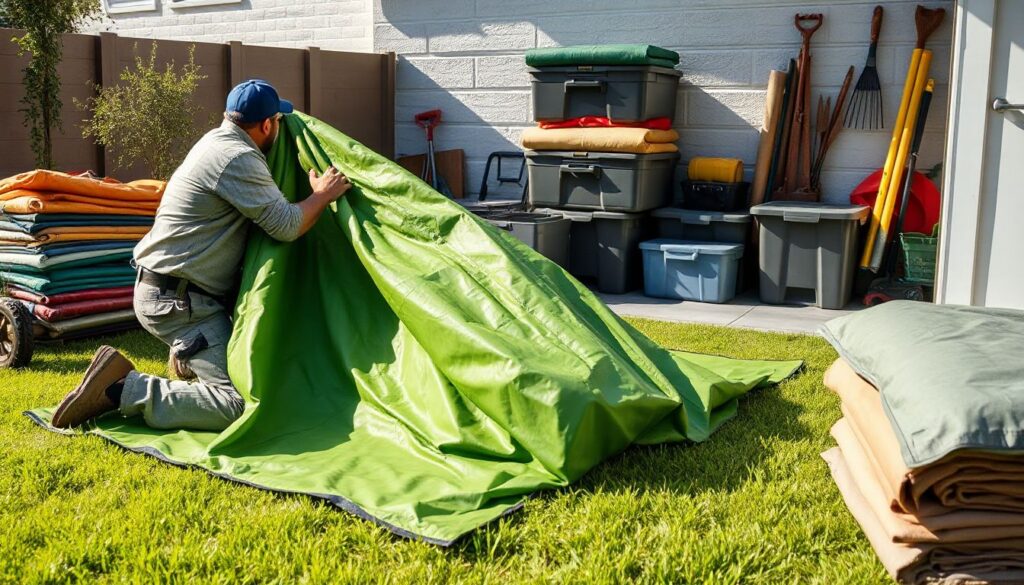Tarpaulins, often called tarps, are tough, adaptable sheets used to shield goods from dust, wind, rain, and sun. They are constructed from polyethylene, vinyl, canvas, or other materials. Vehicles, boats, firewood, outdoor furniture, and even as temporary shelter benefit from Tarpaulins. Proper storage of tarps is essential because they are hefty and cumbersome. They can become damaged, unclean, or consume too much room if not properly folded and stowed.
Begin by Cleaning the Tarpaulin
Make sure a tarpaulin is clean before folding it. Clean the surface using a soft brush or cloth if it has dirt, mud, or any debris on it. Mild soap and water will help you wash the tarp if it is waterproof. Wash off any soap with clear water, then allow it to dry entirely. Letting the tarp dry before storing it is quite crucial. Storing a damp tarp can cause mildew or mold to proliferate, smell bad, and harm the material.
Find a Clean, Dry Area to Fold
To fold your tarp, choose a dry and clean surface. This could be a driveway, a garage floor, or a pristine area of your yard. Folding it on a dirty or damp surface will undo your cleaning efforts and perhaps inflict more damage, so resist doing so. Particularly if the tarp is enormous, it is also useful if the terrain is level and broad.
Place the Tarp Flat
Lay the tarp out flat on the earth. Be certain that all edges are stretched and that no creases or folds exist. Straightening it helps to fold it evenly and lowers wear on some portions of the fabric. Though it might take some time especially with bigger Heavy Duty Tarpaulin it is worth the effort.
Fold the Tarp Halfway Lengthwise
Folding the tarp in half along its longest edge comes first among the steps in folding it. This implies folding it from one long edge to the other, thereby narrowing and lengthening the tarp. As best as you can, attempt to match the corners so the edges line up perfectly. Smoothing the fabric as you fold will help prevent air pockets or creases that might harm the material over time.
Keep Folding Until the Width is Manageable
Keep folding the tarp lengthways till the width is manageable. Fold the tarp until it is around 2 feet wide, for example, if it starts at 12 feet broad. Every fold should be flawless and tight. To flatten the form and eliminate air, push down on the folds. Folding neatly also simplifies later storage of the tarpaulin.
Fold in the Opposite Direction
From one little end toward the other, begin to fold your tarp once it is small enough. This is like folding a towel or blanket. Fold it into pieces till you have a little, square or rectangular form suitable for storage and transportation. Once more, smooth the folds and press down to maintain its flat form.
Tie it Up with Rope or Straps
To hold it closed and taut after folding your tarp, you could use a length of rope, bungee cord, even an old belt. By wrapping it this way, it is kept from unraveling or becoming dirty while stored. It also simplifies carrying, especially if the tarp is heavy. You may run rope through the grommets metal rings of your tarp to aid in maintaining its integrity.
Tarp Should be Stored in a Dry Location
Keep the tarp in a cool, dry location now that it is folded and tied. A shelf in a garage, shed, or basement is perfect. You can use a plastic storage bin with lid or a waterproof bag if you lack indoor area. The purpose is to keep the tarp far from moisture, insects, and direct sunshine especially with plastic or polyethylene tarps, which can degrade the material over time.
Avoid Placing Heavy Items on the Tarp
Store the tarp in a way that does not have heavy items on top of it. This might lead to pressure points and fixed creases. This may progressively degrade the material and cause holes or fissures. Put the tarp on a shelf or in a storage container where it won’t be crushed instead.
Check the Tarp Often
Even when stored, you should occasionally inspect your tarp. Search for tears, tiny holes, or mold stains evidence of damage. Should you discover damage, mend it before resuming the use of the tarp. Depending on the substance, you can employ tarp repair tape, patches, or even a vinyl repair kit. Early fixes for minor problems can spare you needing later-on replacement of the whole tarp.
Label the Tarp if You Have Several
Labeling your tarps is quite useful if you own several. Write on the rope, tag the corner of the tarp, or use permanent ink. For example, boat cover or camping tarp, write the size, use, or where it belongs. This makes finding the one you need easier without having to open every single one to inspect.
After Every Use, Refold the Tarp
Once you finish utilizing your tarpaulin, avoid tossing it in a corner. Before returning it in storage, aim to clean, dry, and fold it one more. A few minutes of treatment every time can help the tarp stay in top condition for many years. People often forget this stage when they are in a rush or exhausted, but it really affects the lifespan of the tarp.
Don’t Keep a Wet or Broken Tarp
Until your tarp is fixed and dry, keep it stored torn or saturated. A torn tarp can keep rips going; a wet one could develop mold and become unusable. Allow the material to dry completely in the sun or in a well-ventilated location after taking time to repair any holes. This is among the most crucial actions in appropriate tarp maintenance.
Final Thoughts
Although folding and storing a tarpaulin may seem like a simple task, doing it properly will save you money, time, and future frustration. Properly storing, tying, folding, and cleaning your tarp guarantees its availability when you need it and safeguards it against damage. A well-kept tarp can last several years, helping you in any sort of scenario and in all weather. Your tarpaulin will be in great condition with little effort and will remain a valuable instrument in your house, garden, or when you are travelling.
For More Info: https://picnobs.blog/

